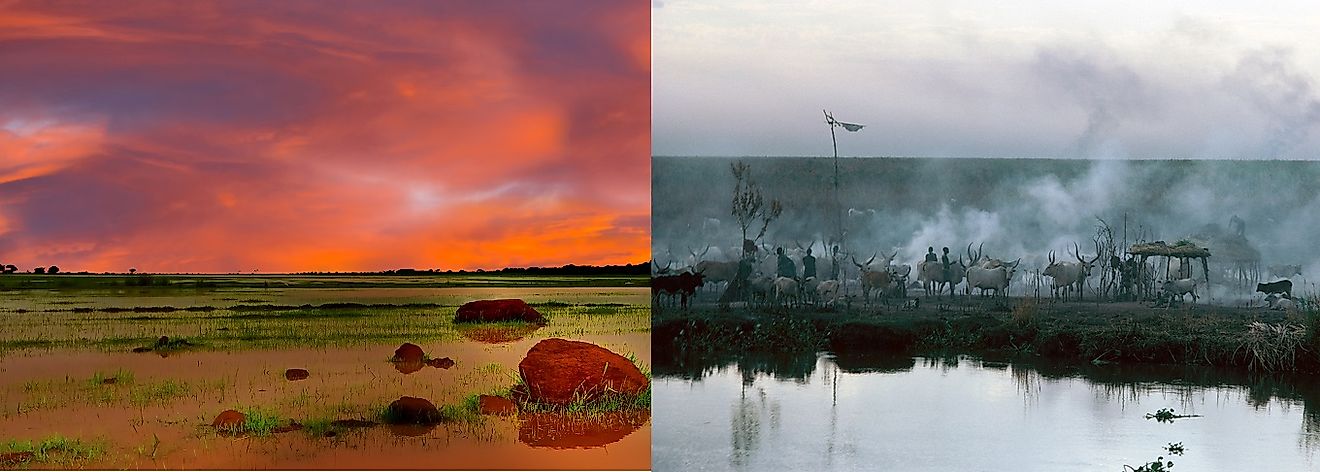Ecological Regions Of South Sudan

South Sudan
South Sudan is an east-central African nation without ocean access. It became a sovereign state independent from Sudan in 2011. This country shares borders with Kenya, Sudan, Ethiopia, Uganda, the Democratic Republic of the Congo, and the Central African Republic. Several ecoregions, rich in biodiversity, stretch across the country. This article takes a look at its various ecoregions.
Tropical and Subtropical Moist Broadleaf Forests
The tropical and subtropical moist broadleaf forest biome, commonly referred to as the jungle, is characterized by hot, humid temperatures and heavy rainfall. Within South Sudan, the East African Montane Forest is the only ecoregion that falls under this description. Given this forests higher altitudes, the temperatures are not as hot as in other jungle regions. This habitat is home to 8 endemic bird species, including Abbott’s starling and Kenrick’s starling, as well as 8 endemic mammal species, including several species of shrew. The biodiversity continues with reptiles of which 9 species are endemic, including the montane viper and 6 chameleon species, to name a few. These forests are threatened by deforestation to make room for cash crops and subsistence farms. Increasing human population is also of concern as development destroys the natural habitat. Humans are also over-hunting and poaching some animal species.
Tropical and Subtropical Grasslands, Savannas, and Shrublands
Grasslands, savannas, and shrublands are a far more common biome throughout South Sudan still yet, and include 5 different ecological regions therein. One of these, the East Sudanian savanna, is hot and arid and filled with Terminalia shrubs and elephant grass. The climate exhibits both rainy and dry seasons. During dry season, the grasses dry up and often burn. Endemic animals include 5 bird species, 2 reptile species, and 1 mammal species. The savanna is home to a large number of endangered animals such as elephants, wild dogs, leopards, and lions. Black and white rhinoceros have been wiped out. Local populations pose a threat to this ecoregion due to their livestock herding and grazing practices, chopping wood for cooking, over-hunting, and poaching.
Flooded Grasslands and Savannas
Within the flooded grasslands and savannas biome, South Sudan has one ecological region, the Saharan Flooded Grasslands. This area floods during rainy season when the West Nile overflows onto the dry surrounding ground. When this happens, many animals use the flooded grasslands as a source of water and plant life is rejuvenated, including wild rice. These water rich areas provide shelter to over 400 bird species and 100 mammal species. Some of these birds include the Shoe-bill, the endangered White pelican, and the vulnerable Black crowned crane. The open lands host thousands of migrating birds and antelope every year. In fact, the flooded grasslands has become important for some antelope species recovery efforts. Poaching is a large problem here. The country is still in post-war rebuilding which has put a strain on its financial resources, ultimately limiting its ability to protect the area.
Montane Grasslands and Shrublands
The montane grassland and shrubland biome in South Sudan contain one ecological region, the East African Montane Moorlands. These moorlands are found at high elevations and host an amazing diversity of plant life. Of the plants found in this ecoregions, 81% are considered endemic. Some of these plants include the giant groundsels and lobelias. Birds are also numerous and include such species as the Regal sunbird, Rockefeller’s sunbird, and Stuhlmann’s double-collared sunbird. Unfortunately, this extremely biodiverse region is also quickly declining. Agricultural practices lead to deforestation, livestock overgrazes the plant life, and fires destroy its surroundings.
Ecological Regions Of South Sudan
| Ecological Regions of South Sudan | Biome |
|---|---|
| East African Montane Forests | Tropical and Subtropical Moist Broadleaf Forests |
| East Sudanian Savanna | Tropical and Subtropical Grasslands, Savannas, and Shrublands |
| Northern Acacia-Commiphora Bushlands and Thickets | Tropical and Subtropical Grasslands, Savannas, and Shrublands |
| Northern Congolian Forest-Savanna Mosaic | Tropical and Subtropical Grasslands, Savannas, and Shrublands |
| Sahelian Acacia Savanna | Tropical and Subtropical Grasslands, Savannas, and Shrublands |
| Victoria Basin Forest-Savanna Mosaic | Tropical and Subtropical Grasslands, Savannas, and Shrublands |
| Saharan Flooded Grasslands | Flooded Grasslands and Savannas |
| East African Montane Moorlands | Montane Grasslands and Shrublands |











